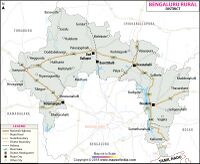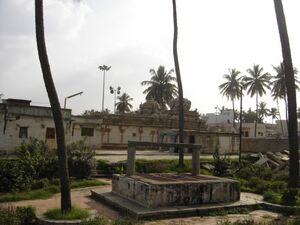Begur
| Author:Laxman Burdak, IFS (R) |
Begur (बेगुर) village is located in Bangalore North Tehsil of Bangalore district in Karnataka, India. It is located off Bengaluru-Hosur highway. It is said to have been a prominent place during the rule of the Western Ganga Dynasty and later the Chola Kingdom. It is known for Naganatheshvara Temple (9th century).
Variants
Location

The location code or village code of Begur village is 612902. Begur village is located in Bangalore North Tehsil of Bangalore district in Karnataka, India. It is situated 30km away from sub-district headquarter Bangalore North and 30km away from district headquarter Bangalore. As per 2009 stats, Doddajala is the gram panchayat of Begur village. The total geographical area of village is 185.99 hectares. Begur has a total population of 434 peoples. There are about 93 houses in Begur village. As per 2019 stats, Begur villages comes under Byatarayanapura assembly & Bengaluru North parliamentary constituency. Devanahalli is nearest town to Begur which is approximately 12km away.[1]
Begur Fort
Panchalingeshwara temple is located in the centre of Begur. It has a 1100 years old inscription which is the oldest existing reference to a place called 'Bengaluru'. The area was ruled by the Western Ganga Dynasty and in the 10th century the Cholas had acquired the territory.
Nageshwara temple

The Nageshwara temple was built by Ereganga Neetimarga around 9th century and Panchaligeshwara temple was built by Akthiyar of the Chola Kingdom.
Near the temple, there exists a tiny circular fort, about 1.4 km² in area, is built by the Cholas. The date of construction is unknown (no research done), but the existence of a 1100-year-old inscription on the gateway of the fort would suggest the same age for the fort.
The name "Bangalore" represents an anglicised version of the Kannada language name and its original name, "Bengalūru". It is the name of a village near Kodigehalli in Bangalore city today and was used by Kempegowda to christen the city as Bangalore at the time of its foundation.
The earliest reference to the name "Bengalūru" was found in a ninth-century Western Ganga Dynasty stone inscription on a "vīra gallu" (literally, "hero stone", a rock edict extolling the virtues of a warrior). In this inscription found in Begur, "Bengalūrū" is referred to as a place in which a battle was fought in 890 CE. It states that the place was part of the Ganga Kingdom until 1004 and was known as "Bengaval-uru", the "City of Guards" in Halegannada (Old Kannada).[2][3]
The Nageshvara temple complex (also spelt Nagesvara and called Naganatheshvara locally) is located in Begur, a small town within the Bangalore urban district of Karnataka state, India. From inscriptions, it is known that Begur was once called Veppur, and Kelele (in Western Ganga King Durvinita's Mollahalli grant inscription of 580-625 C.E.). Two shrines within the temple complex, the Nageshvara and Nageshvarasvami were commissioned during the rule of Western Ganga Dynasty Kings Nitimarga I (also called Ereganga Neetimarga, r. 843-870) and Ereyappa Nitimarga II (also called Ereganga Neetimarga II, r. 907-921). The remaining shrines are considered a later day legacy of the rule of the Chola Dynasty over the region.[4] An Old Kannada inscription, dated c. 890, that describes a "Bengaluru war" (modern Bangalore city) was discovered in this temple complex by the epigraphist R. Narasimhachar. The inscription is recorded in "Epigraphia Carnatica" (Vol 10 supplementary). This is the earliest evidence of the existence of a place called Bengaluru.[5] as per Agamik Girish deekshit the chief priest the Nageshwara swamy shrine is oldest among Panchalinga’s it was bodayana Maharishi who built the main temple.
बेगुर शिलालेख
बेगुर (Begur) के पास मिले एक शिलालेख से ऐसा प्रतीत होता है कि यह जिला 1004 ई० तक, गंग राजवंश का एक भाग था। इसे बेंगा-वलोरू (Bengaval-uru) के नाम से जाना जाता था, जिसका अर्थ प्राचीन कन्नड़ में "रखवालों का नगर" (City of Guards) होता है। सन् 1015 से 1116 तक तमिलनाडु के चोल शासकों ने यहाँ राज किया जिसके बाद इसकी सत्ता होयसल राजवंश के हाथ चली गई।
बेगूर कर्नाटक राज्य के बंगलोर शहरी ज़िले में स्थित एक नगर है। यह बंगलुरु का एक उपनगर है। राष्ट्रीय राजमार्ग 44 और राष्ट्रीय राजमार्ग 48 इसके समीप से गुज़रते हैं।
नागेश्वर मंदिर, बेगुर
नागेश्वर मंदिर, बेगुर (Nageshvara temple, Begur) - बेगुर में स्थित नागेश्वर मंदिर को स्थानीय लोग नागनाथेश्वर मंदिर बोलते हैं. बेगूर कर्नाटक राज्य के बंगलोर शहरी ज़िले में स्थित एक नगर है। यह बंगलुरु का एक उपनगर है। राष्ट्रीय राजमार्ग 44 और राष्ट्रीय राजमार्ग 48 इसके समीप से गुज़रते हैं।
नागेश्वर मंदिर, बेगुर के शिलालेखों से यह ज्ञात है कि बेगुर को कभी वीपुर (Veppur) और केल (Kelele) कहा जाता था (पश्चिमी गंगा राजा दुर्विनीता का मोलहल्ली में 580-625 ई. का शिलालेख). मंदिर परिसर के भीतर दो तीर्थस्थल हैं: नागेश्वर और नागेश्वरस्वामी जो पश्चिमी गंगा राजवंश के समय निर्मित किए गए थे. ये राजा थे - नितीमर्ग I (843-870) और एरेयप्पा नितीमर्गा II (907-921). शेष मंदिरों को इस क्षेत्र में चोल राजवंश के शासन की बाद की विरासत माना जाता है. एक पुराना कन्नड़ शिलालेख (c.890) "बेंगलुरु युद्ध" (आधुनिक बैंगलोर शहर) का वर्णन करता है, जो इस मंदिर परिसर में एपिग्राफिस्ट आर. नरसिम्हाचर द्वारा खोजा गया था। यह शिलालेख "एपिग्राफिया कर्नाटिका" (वॉल्यूम 10 पूरक) में दर्ज किया गया है। यह बेंगलुरु नामक जगह के अस्तित्व का सबसे पहला सबूत है।
बेगुर (Begur) के पास मिले एक शिलालेख से ऐसा प्रतीत होता है कि यह जिला 1004 ई० तक, गंग राजवंश का एक भाग था। इसे बेंगा-वलोरू (Bengaval-uru) के नाम से जाना जाता था, जिसका अर्थ प्राचीन कन्नड़ में "रखवालों का नगर" (City of Guards) होता है। सन् 1015 से 1116 तक तमिलनाडु के चोल शासकों ने यहाँ राज किया जिसके बाद इसकी सत्ता होयसल राजवंश के हाथ चली गई।
External links
References
- ↑ https://villageinfo.in/karnataka/bangalore/bangalore-north/begur.html
- ↑ Chandramouli, K (25 July 2002). "The city of boiled beans". The Hindu. Chennai, India.
- ↑ "Inscription reveals Bengaluru is over 1,000 years old". The Hindu. Chennai, India. 20 August 2004.
- ↑ Sarma, I.K. (1992) [1992]. Temples of the Gangas of Karnataka. New Delhi: Archaeological Survey of India. ISBN 0-19-560686-8.p.78
- ↑ "Inscription reveals Bangalore is over 1,000 years old". The Hindu. 20 August 2004.

